

Dryland rice production was enhanced by Gaia Green fertilizer, but not by Mykos Gold, Yeast Guard, or Tecamin MAX biostimulants
Sustainable Agriculture Student Research Project
Effects of Biostimulant and Mycorrhizal Inoculant Applications on Dry Direct-Seeded RiceNaomi Mallare, Department of Sustainable Agriculture, 2024 |
Introduction
For millennia, rice has been grown in flooded fields to suppress weeds and produce higher grain yields (Fuller et al. 2011; Alagbo et al. 2022; Vistan 2023), but flooded rice fields are conducive to methane production (Li et al. 2005). Moreover, flooding rice uses up fresh water reserves and degrades soil quality (Liu et al. 2015). Alternatively, dry direct-seeded rice production can be more profitable and produce less methane (Fatima et al. 2020; Magar et al. 2022).
Amendments like biostimulants and mycorrhizal inoculants may help rice grow in dry, direct-seeded fields. Since dryland rice production is a relatively new production system, there is little research on the effects of biostimulants and mycorrhizal inoculants in unflooded conditions. By measuring plant dry matter accumulation of roots and shoots as indicators of growth promotion, this experiment aimed to gather more knowledge on the effects of biostimulants and mycorrhizal inoculation of rice in dry direct-seeded production systems with different fertility levels.
Three amendments intended to promote rice growth were tested in this study:
- Mykos Gold - a powdered mycorrhizal inoculant intended to increase water and nutrient uptake
- Used with K3NEO Seed Spray - a biostimulant intended to increase fertilizer uptake;
- Yeast Guard Foliar Spray - a biostimulant intended to increase the root system, tillering, and grain yield; and
- Tecamin MAX Foliar Spray - a liquid foliar fertilizer, intended to increase water retention and absorption and promote growth.
Methods
- Location: KPU Farm, Garden City Lands, Richmond B.C.
- Experimental Design:
- Completely Randomized Factorial Design with two replicates of four factors at two levels each (Figures 1-5):
- Gaia Green: High or low fertility (see Seeding & Treatments)
- Mykos Gold: +/-
- Yeast Guard Foliar Spray: +/-
- Tecamin MAX Foliar Spray: +/-
- 32 experimental plots, 37 cm by 56 cm (0.2 m2), 25 cm deep, in an 8 by 4 grid (Figures 1, 2)
- Completely Randomized Factorial Design with two replicates of four factors at two levels each (Figures 1-5):
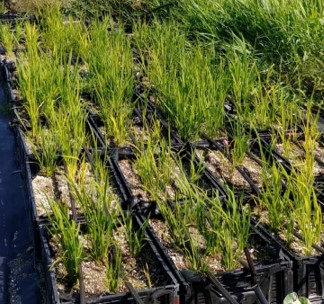

- Growing Medium
- 50% sand
- 23.5% perlite
- 23.5% vermiculite
- 3% biochar
- 3.78 g of Gaia Green 4-4-4 organic fertilizer (18 g/m2) in each experimental crate
- Seeding & Treatments
- Rice directly seeded in the crates, 12 seed clumps in each plot, 5 seeds per clump, about 2 cm deep
- Mykos Gold treatment: seeds sprayed with K3NEO seed spray, then coated with powder mycorrhizal inoculant (Figure 4)
- Yeast Guard and Tecamin MAX foliar sprays were sprayed for leaf coverage once every two weeks; treated plots were surrounded with cardboard barriers at each spray (Figure 6)
- Gaia Green was applied at high and low fertility levels
- High fertility treatment: 200g of Gaia Green, hand raked, every 2 weeks
- Low fertility treatment: 200g of Gaia Green, hand raked, at emergence, heading, and when severe nutrient deficiency symptoms observed
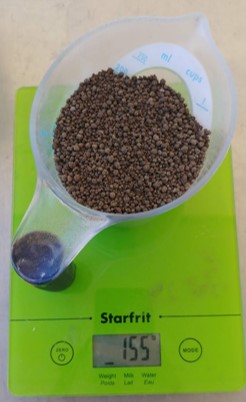
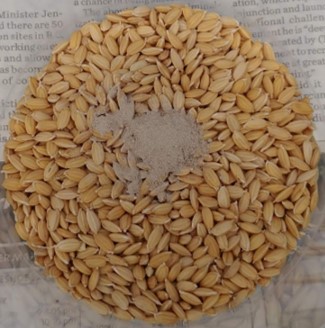
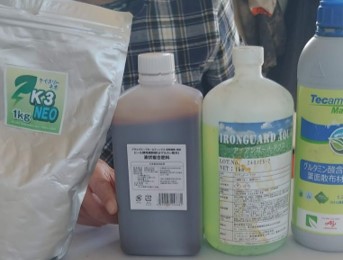
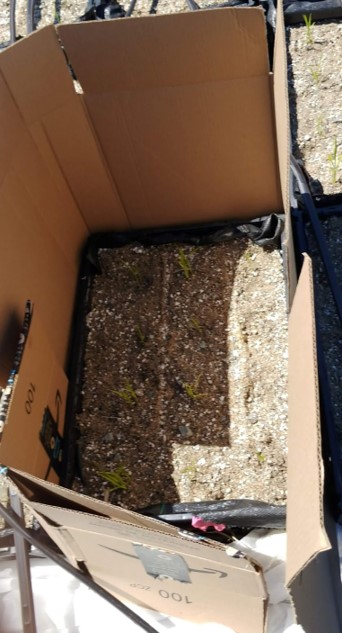
- Data Collection
- Harvest Date: October 9th, 2024
- Processing: roots washed in tub, plants dried until no longer dripping, divided by roots and shoots, bagged, dried in drying oven @ 70°C until dry weights stabilized
- Dry bag weight was subtracted to get actual dry matter weight
- Statistical Analysis
- ANOVA (jamovi interface for R)
- Dependent Variables: Dry weight per plot and per plant
- Fixed Factors: Mykos Gold, Yeast Guard, Tecamin MAX, Gaia Green
- ANOVA (jamovi interface for R)
Results
- Significant benefit from Gaia Green fertilizer (p = 0.005)
- No significant effects of Mykos Gold and K3NEO seed spray, Tecamin Max foliar spray, or Yeast Guard foliar spray
- No significant effects on root:shoot ratio: There is no evidence to support the claim that Yeast Guard foliar spray increases root system growth
- No interactions between treatments: There is no evidence to support the claim that amendments improve nutrient uptake in low-nutrient environments
Table 1. ANOVA for average dry weight per plot. Only in the Gaia Green fertility treatment had a significant effect on plant dry weight.
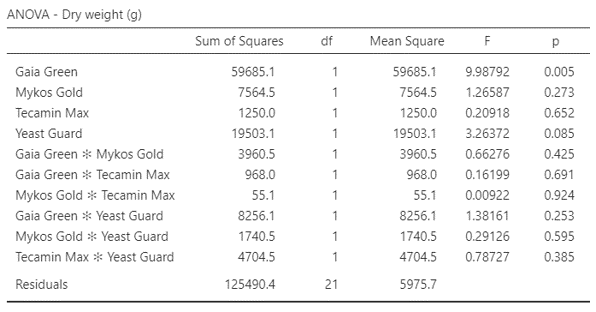
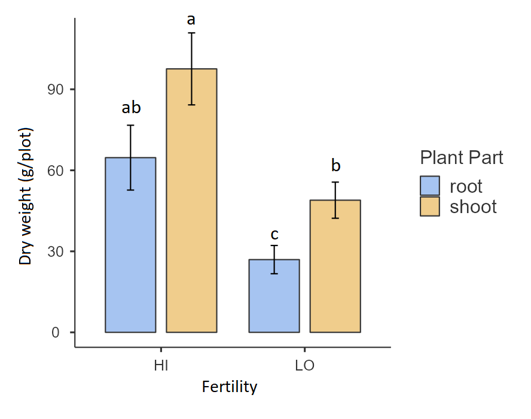
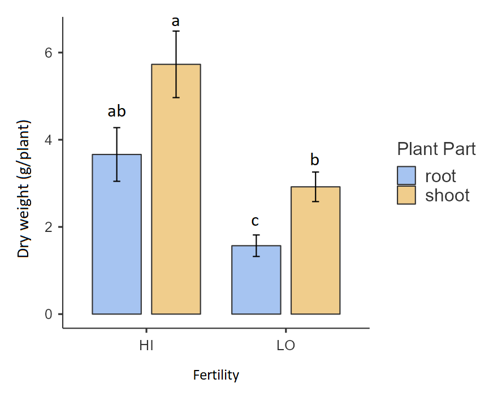
Discussion
The results do not provide sufficient evidence to reject the null hypotheses that bio-stimulants have no effect on increased growth, measured by plant dry matter accumulation of roots and shoots, and that the mycorrhizal inoculant has no effect on increased water and nutrient uptake, measured by plant dry matter accumulation of roots and shoots. The results provide evidence that the fertility treatment has a significant effect on overall plant growth.
The results were insignificant possibly due to these reasons and variations in this study:
- Failed germination because of bird attacks at initial seeding
- Difference in germination times because of the consequential reseeding
- Difference in number of seeds per plot because of the bird attack & reseeding
- While the analyses accounted for this by taking the average weight per plant on top of weight per plot, perhaps future studies could work with transplants instead to have a certainly standard number of plants across experimental plots
- The growing medium was not the type of soil typically used to grow rice. Maybe amendments would work better if grown in proper soil, instead of a very sandy growing medium
- If future experiments would benefit to 1) try this in less sandy soil, and 2) if using sandy soil for ease in root-washing, use more of the amendments to account for the sandiness
Conclusion
- Rice plants grew better in the higher fertility environments with more Gaia Green fertilizer, but none of the other tested amendments improved growth.
- The advertised amendments are not recommended to purchase until more research can support their economic and agricultural value.
Acknowledgements
- Thank you, Mr. and Mrs. Shiroki, and Akio Nakamura for the rice cultivation mentorship and donation of seed, mycorrhizal inoculant, and biostimulant amendments.
- Thank you, Dr. Mike Bomford and Dr. Rebecca Harbut for the guidance in research and production.
- Thank you Sahar Zandieh, Ben Alles, and the Waite family for your labor support in this project.